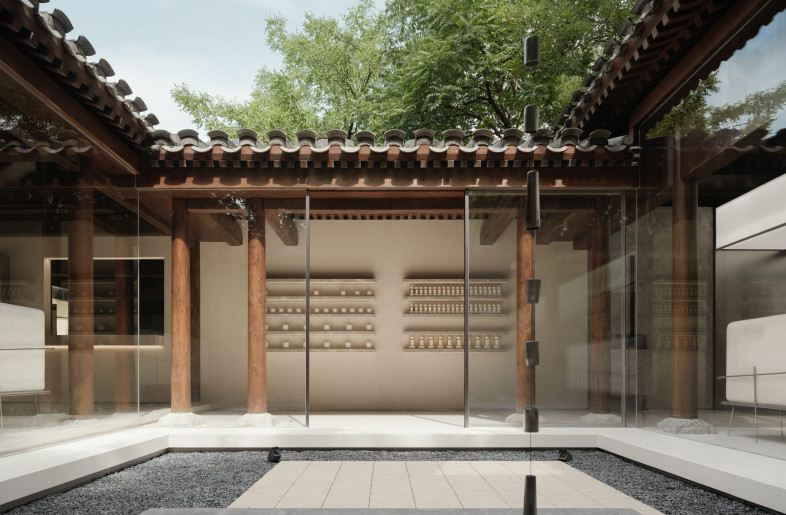Minimalist interior design is a contemporary style that emphasizes simplicity, functionality, and a sense of balance. It's characterized by clean lines, neutral colors, and a focus on essential elements, making spaces feel uncluttered and harmonious. One intriguing branch of minimalism is Japandi, a fusion of Japanese and Scandinavian design principles that marries the elegance of Japanese aesthetics with the functional sensibilities of Scandinavian design. This unique blend offers a harmonious balance between tranquility and practicality, creating spaces that exude warmth and simplicity. While Japandi is a trending search-term in 2020 onward, the style has clear roots too the minimalism present in mid-century modern architecture.
Japandi seeks to create an atmosphere that captures the organization of Japanese interiors and the functional, timeless appeal of Scandinavian design. This style emerged as a response to the fast-paced and cluttered world, offering a sanctuary of calmness and balance within our living spaces. The old Japanese philosophy known as wabi-sabi is an important belief for understanding the Japandi style. One key element is the motivation to live a simple life, and rather than perfection, we can seek balance. “Nothing lasts, nothing is finished, nothing is perfect”


(images above of internal courtyards in a timber-clad bungalow designed by Osaka-based practice Arbol in Akashi, Japan. Read full home review here at Dezeen.com)
The 'Scandinavian' roots of Japandi can be traced back to the mid-20th century when Alvar Aalto, a renowned Finnish architect and designer, integrated elements of Japanese aesthetics into his creations. Aalto's designs often embraced natural materials, organic forms, and a focus on human comfort. His work laid the foundation for the fusion of Japanese and Scandinavian design sensibilities that would later become the Japandi style.

(image of Carré House by Alvar Aalto. Minimalist style interior. Photo found at dwell.com)

(image of Carré House by Alvar Aalto. Minimalist style interior. Photo found at dwell.com)
Another noteworthy anecdote on the matter of Scandinavian influence, it is impossible to ignore the existence of Ikea. As a household name for furniture across the globe, Ikea was founded exactly in the mid-century. Starting in 1943, Ikea has been a major Swedish influence to what we can refer to as 'Scandinavian minimalism.'

(image of Ikea furniture. Read Ikea's article about minimalist furniture here.)
Materials and Aesthetics:
Japandi interiors often showcase a harmonious blend of natural materials such as light woods, bamboo, stone, and ceramics. Neutral color palettes dominated by soft hues like whites, grays, and muted earth tones are characteristic of this style. The emphasis on texture and tactile experiences adds depth and warmth to spaces, creating an environment that invites relaxation and introspection.
Below you see one of our kitchen designs that utilizes white oak and white solid surface. Open shelves reveal activity. Linear ceiling baffles make the space feel cozier. Elements of an engawa deck are seen to the North. The low table replaces the trending use of a kitchen island, minimizing the casework present in the room.

(image of Japandi Kitchen by Studio North)

(image of Japandi Dining Area by Studio North)
Conversely, we do not see enough mention of modern Chinese influence. While traveling in Beijing, we came across a few renovated 'Hutong' style homes. The traditional elements of a Hutong go as far back as 1300 AD. Elements such as central courtyards with interiors that face inward made many of these spaces perfect candidates for minimalist masterpieces. In contrast to the warm tones of cypress and cedar that we see in Japanese design, the neutral comfort of pine and oak in the Scandinavian design, we see really special implementation of masonry in the Chinese Hutong. Additionally, the meticulous ancient memory frames very unique openings.

(image of No. 28 dayuan hu tong, Beijing- by Hu Yue Studio)


(view of ToSummer aromatherapy store in Beijing. by FOG Architecture.)

(image of House of Wang, Beijing)



(images of projects by Chaoffice, based in Bejing)
In summary, cultural roots can be blurred by the natural world, which is at the heart of what this trend is reaching for. History repeats itself, and perhaps whether we are looking to Beijing, Tokyo, Stockholm, or Tulum- we see natural materials that are placed with the same care as a painter would compose a masterpiece. Framed moments for our eyes to look toward and rest- organized beauty in a chaotic world.
Furniture Companies and Layouts:
Numerous furniture companies have embraced the Japandi aesthetic, offering pieces that marry Japanese craftsmanship with Scandinavian functionality. Brands like Muuto, Maruni, and Karimoku New Standard are known for producing furniture that embodies the essence of this fusion. Japandi layouts prioritize open, uncluttered spaces with a focus on functional furniture arrangements. Low-profile furniture, modular designs, and multi-purpose pieces contribute to the clean and adaptable nature of Japandi interiors.
In conclusion, Japandi interior design represents a harmonious blend of Japanese tranquility and Scandinavian practicality. Inspired by the minimalist philosophies of both cultures, it offers a serene and functional aesthetic that transforms living spaces into havens of simplicity and balance. Through its historical influences, material choices, furniture options, and thoughtful layouts, Japandi design invites individuals to embrace a lifestyle that values both aesthetic elegance and everyday functionality.

Comments